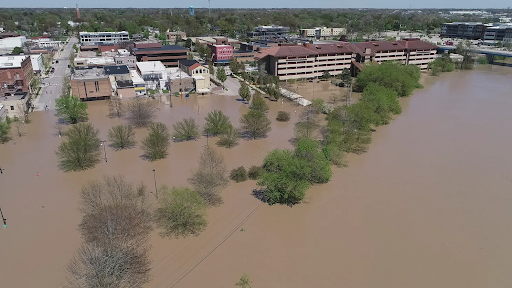Dam failure devastates Midland residents

Midland’s dam failure led to most of the town being submerged in floodwater (Photo courtesy of Kelly Jordan and Junfu Han)
June 12, 2020
After days of heavy rainfall in mid-May, over ten thousand residents of Midland County, MI were forced to evacuate as the town quickly flooded due to a dam failure.
The Edenville Dam was the first to rupture, causing almost 3.4 billion cubic feet of water from Wixom Lake to be drained into the Tittawabassee River. Overwhelmed by the sudden increase in water, the river’s force caused the Sanford Dam to fail, devastating the city and forcing residents to take shelter in high schools, community centers, or the homes of family and friends.
At its peak, the floodwaters were as high as 35 feet, completely submerging parts of the town. Within several hours, the muddy brown water blanketed Midland, damaging over 2,500 homes, businesses, and nonprofits. The damage has been estimated at $175 million, prompting Governor Gretchen Whitmer to ask the federal government to assist Midland in its long road to recovery.
Wixom Lake, on the contrary, is now almost completely empty. The lake, which now looks like nothing more than a muddy pit, has a haunting appearance, being full of stranded boats, exposed docks, and dead fish. Enjoying the lake during the summer months has become nothing but a distant memory to heartbroken lakeside homeowners.
Many of the homes that were damaged by the flooding were in typical non-flooding zones, which caused residents to be in a state of confusion as they were ordered to evacuate immediately. Citizens of Midland, which are used to flooding and evacuation orders, were unaware of the urgency of the command. Jenn Desco, a resident of Midland, described the ordeal as a “nightmare movie.”
The alarming floodwaters could also be catastrophic to the many species that inhabit Midland. “The floods can cause organisms to drown, carry disease, and force migration to other areas that may not be able to handle the influx of population,” explained AP Environmental Science teacher Stephanie Crow.
The disturbance of the plants and soil in the area have the potential to create long-lasting negative impacts on Midland’s ecosystem. “Depending on the soil that is there and the types of plants, the flooding may impact the system just a bit all the way to catastrophic,” began Crow. “If the soil is sandy and the plants are riparian, or water loving, it could be back to normal very quickly. Otherwise, it might take a while.”
As June progresses, the flooding has died down, but the disastrous aftermath lingers over the town. Recovery has begun as Midland residents begin to return to the city, assess damages, and clean up what was destroyed. Water testing kits for citizens with groundwater wells have been distributed to test for any possible contamination, and vaccine clinics have been opened to protect those who are working in potentially harmful flooded areas.
Midland’s recovery process takes more than just rebuilding; floodwaters can be contaminated with harmful toxins that can promote the contraction of various diseases, making the removal of the water a priority. “Floods can be remediated if proper repairs are put into place,” explained Crow. “Adding riparian plants along the water’s edge can help absorb water and phytoremediating plants can absorb toxins that may have entered the water system.”
In order to help Midland residents during this stressful time, donations can be made to the Midland County Emergency Food Pantry, the Midland Salvation Army, and/or United Way of Midland County. Those who would like to donate resources that would be helpful during the recovery process can complete United Way’s flood relief survey online. With the support from its community, Midland will persevere and once again be the place that over forty thousand people call home.